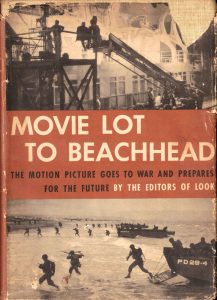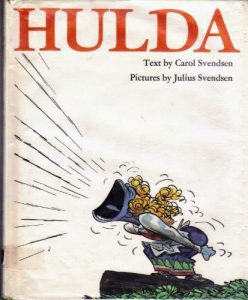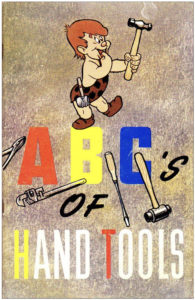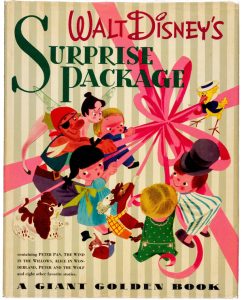Suspended Animation Special
I was recently communicating with Jerry Beck and I pointed out that while we may be quite familiar with some things – that those same things might be unknown to many of the readers of this site. I am following up on that discussion by listing some fairly obscure Disney animation related books that may fall into that category.
 Movie Lot to Beachhead by the editors of LOOK (Doubleday, Doran and Company 1945). While there have been many books telling the story of Hollywood going to war, this is perhaps one of the best because it was written right while it was happening. The book doesn’t just concentrate on the hundreds of war oriented movies that the major movie studios were releasing along with some stills that seem never to have been reprinted elsewhere, but it also contains rare stills and commentary on the many shorts and propaganda films that were produced at the time.
Movie Lot to Beachhead by the editors of LOOK (Doubleday, Doran and Company 1945). While there have been many books telling the story of Hollywood going to war, this is perhaps one of the best because it was written right while it was happening. The book doesn’t just concentrate on the hundreds of war oriented movies that the major movie studios were releasing along with some stills that seem never to have been reprinted elsewhere, but it also contains rare stills and commentary on the many shorts and propaganda films that were produced at the time.
For the Disney collector, there is a still from “The New Spirit”, the Donald Duck short designed to get people to pay their taxes as well as a still from another Donald patriotic short entitled “Get In the Scrap”
There are also twenty-three stills arranged in storyboard format (with appropriate narration underneath) from “El Enemigo Unvisible” (“The Unseen Enemy”), a Walt Disney health education film warning people in Latin America against microbes in water and soil. Here is an excellent example of how Disney effectively used animation as a teaching aid.
Animation historians will probably also get a kick out of a similar storyboard included from the Private Snafu short “Booby Traps”. Snafu was an animated character who was constantly getting into trouble so that servicemen could learn from the experience. Chuck Jones and Ted “Dr. Seuss” Geisel were involved with the character. There are many “behind the scenes” shots of the live action war movies produced at the time. The text is typically gung-ho patriotic in tone but provides a surprising amount of factual information unavailable elsewhere.
 Hulda. Story by Carol Svendsen and illustrations by Julius Svendsen (Houghton Mifflin Company, 1974, 28 pages long). Hulda was a delightful and pleasant young girl. Her manners were charming. You would probably say that Hulda was as sweet as an angel. And she was–just as long as she got her own way. If she didn’t, watch out!
Hulda. Story by Carol Svendsen and illustrations by Julius Svendsen (Houghton Mifflin Company, 1974, 28 pages long). Hulda was a delightful and pleasant young girl. Her manners were charming. You would probably say that Hulda was as sweet as an angel. And she was–just as long as she got her own way. If she didn’t, watch out!
Say “no” to Miss Hulda and she would begin such a terribly, horribly loud screaming that even the bold and hardy Vikings had to give in. Hulda was spoiled. There was no doubt. That is until she went “berrying” one day against everyone’s advice. She encountered a huge but very young troll. He was no match for Hulda’s screaming, and so called his mother to help.
But, she, too was quickly convinced by the ear splitting, spine chilling screams to let Hulda have her own way. And so she did until she met the most majestic, titanic father troll of them all.
This book was done by the Svendsens. Carol Svendsen was a native of Greeley, Colorado. In 1948, she began working for the Walt Disney Studios. Two years later, she married one of her co-workers, a Norwegian-born illustrator named Julius Svendsen.
Some of you probably recognize the name since he was involved in the three Ward Kiimball space shows for the Disneyland televison show in the Fifties. Julius was a veteran animator by that time and contributed to many full-length animated features produced by Disney until his untimely death in 1971.
The artwork is very reminiscent of the work of another Disney artist who did children’s books, Bill Peet. An oddity about this book is that Julius passed away in 1971 but the copyright on the book is 1974.
 ABC’S of Hand Tools (Public Relations Staff, General Motors Corporation, 1945). Even into the Seventies, it was possible to receive a copy of this pamphlet free from General Motors but as soon as a book entitled “Things You Can Get for Free” was published, the supply was quickly depleted. The pamphlet is about fifty pages long, and concentrates on the correct usage and care of hand tools. That doesn’t sound interesting until you realize that this is the companion pamphlet to a Disney education film of the same name.
ABC’S of Hand Tools (Public Relations Staff, General Motors Corporation, 1945). Even into the Seventies, it was possible to receive a copy of this pamphlet free from General Motors but as soon as a book entitled “Things You Can Get for Free” was published, the supply was quickly depleted. The pamphlet is about fifty pages long, and concentrates on the correct usage and care of hand tools. That doesn’t sound interesting until you realize that this is the companion pamphlet to a Disney education film of the same name.
The problems are demonstrated through the use of a little cartoon character called Primitive Pete who looks a lot like a caricature of Ward Kimball or at least a close cousin to a similar character in the Disney propaganda short, “Reason and Emotion.” All drawings of Primitive Pete contained in this booklet are copyrighted 1943 by Walt Disney Productions” proclaims the first page as we are introduced to this little unshaven caveman in a leopard skin carrying a stone hammer.
Originally the book was prepared in a slightly different form for use by the U.S. Armed Forces. It was supplied in large quantities to help the training of mechanics. The revised booklet which was given away through the 1970s was prepared to help out the civilian mechanic with similar problems (like using the right size screwdriver and how dangerous it is to use a file without a handle). There is at least one and many times two pictures on each page of Pete getting into all sorts of predicaments, his baby face sometimes looking sheepishly at the reader.
 Walt Disney’s Surprise Package (Simon and Schuster, 1944, stories adapted by H. Marion Palmer). Helen Marion Palmer was the wife of Ted “Dr. Seuss” Geisel and authored some Disney related books during this time period. By 1945, the demand for this book was so great it had already gone through three different printings. With World War II preventing Walt from developing new animated features and limiting his ability to produce animated shorts, it is not surprising that this book appears to be first draft story concepts for later Disney projects.
Walt Disney’s Surprise Package (Simon and Schuster, 1944, stories adapted by H. Marion Palmer). Helen Marion Palmer was the wife of Ted “Dr. Seuss” Geisel and authored some Disney related books during this time period. By 1945, the demand for this book was so great it had already gone through three different printings. With World War II preventing Walt from developing new animated features and limiting his ability to produce animated shorts, it is not surprising that this book appears to be first draft story concepts for later Disney projects.
For instance, one story is entitled “Lady” and is about the famous Lady of “Lady and the Tramp”. However, Tramp does not appear in this story and it is probably very close to the original version pitched by storyman Joe Grant. The two Siamese cats appear and it is Lady who rescues the new baby from the cats’ claws, is wrongly accused of threatening the baby and finally vindicated.
The book is an anthology of twelve stories: “Through the Picture Frame” (based on Hans Christian Andersen), “B’rer Rabbit en His Stachel uv Gold,” “The Emperor’s New Clothes,” “The Little Fir Tree” (another Andersen tale perhaps developed for the unmade Andersen film project), “Lady” (one of two stories credited specifically to the Walt Disney Studio), “Chicken Little,” “Alice’s Adventures in Wonderland,” “The Wind in the Willows,” “Peter Pan and the Pirates,” “Peter and the Wolf,” “The Square World” (the other story credited solely to the Disney Studio and it is the work of Dick Huemer and Joe Grant to the best of my knowledge…a tribute to Joe Grant in the Florida Disney Feature Animation lobby had some examples of this artwork credited to Grant), and “Happy Valley” (credited as “from an English Folk Tale”). This is the Mickey, Donald and Goofy in the famous “Mickey and the Beanstalk”.
 “The Square World” tells the story of a land run by a square dictator who insists that everything and everyone in his land be made square. He finally orders that only square babies can be born but there are some things even a dictator cannot control and when he sees all the normal babies, he promptly commits suicide.
“The Square World” tells the story of a land run by a square dictator who insists that everything and everyone in his land be made square. He finally orders that only square babies can be born but there are some things even a dictator cannot control and when he sees all the normal babies, he promptly commits suicide.
Many of these stories were in some form of production when this book appeared and some of the illustrations that accompany them seem to be concept sketches, pencil sketches or slightly reworked storyboard sketches. The drawings for “Alice’s Adventures in Wonderland” are based on the famous Tenniel drawings.
There are many many more of these books featuring obscure art by Disney artists. Would you like me to do further posts like this? And more importantly – do you have any such books? I’m curious to know if there are any I don’t have!


 Jim Korkis is an internationally respected animation historian who in recent years has devoted his attention to the many worlds of Disney. He was a columnist for a variety of animation magazines. With his former writing partner, John Cawley, he authored several animation related books including The Encyclopedia of Cartoon Superstars, How to Create Animation, Cartoon Confidential and Get Animated’s Animation Art Buyer’s Guide. He taught animation classes at the Disney Institute in Florida as well as instructing classes on acting and animation history for Disney Feature Animation: Florida.
Jim Korkis is an internationally respected animation historian who in recent years has devoted his attention to the many worlds of Disney. He was a columnist for a variety of animation magazines. With his former writing partner, John Cawley, he authored several animation related books including The Encyclopedia of Cartoon Superstars, How to Create Animation, Cartoon Confidential and Get Animated’s Animation Art Buyer’s Guide. He taught animation classes at the Disney Institute in Florida as well as instructing classes on acting and animation history for Disney Feature Animation: Florida.




















































Great post. And, Yes, I’d love to read more.
Interesting that a collection of unused concept art and storyboards would be so successful in book form. It’s a wonder that Disney didn’t do that more often.
I’d be interested in reading about deluxe editions such as Deems Taylor’s companion volume to “Fantasia”. I’d also be curious to know about any Disney artists who worked in fields you wouldn’t expect them to, like scientific or technical illustration, or cartoons for Playboy.
I don’t know whether this is an obscure book or not, but my mother had an old book from her childhood called “Mickey Mouse Illustrated Movie Stories”, with about ten of his early black-and-white adventures written out in prose and accompanied by stills from the cartoons. On the lower page corners were little pictures of Mickey and Minnie, and when you flipped through the pages, they would dance for you! “Mickey Mouse Illustrated Movie Stories” would have been one of my mother’s first books in English; certainly it was the oldest one that she held onto as an adult. So it’s fitting that one of my first books in German (that wasn’t a hand-me-down from my mother) was “Das grosse Disney-Bilderbuch” (The big Disney picture book), containing stories from Bambi, Pluto and the Armadillo, etc. Disney storybooks can be very helpful when you’re learning a new language, at any age.
I’ve lived with a first printing of “Surprise Package”, well, my entire life. My folks must have bought the copy for my brother and/or sister two years before I was born. (“A Giant Golden Book” doesn’t appear on the cover of this printing.) Interestingly, the images that were always fixed most firmly in my mind were those of “The Square World”.
My friend and much respected Disney historian Didier Ghez recently shared the identifications of the artists in the Surprise Package book:
1. Through the Picture Frame: Bianca Majolie
2. Brer Rabbit En His Satchel Uv Gold: Unknown
3. The Emperor’s New Clothes: James Bodrero
4. The Little Fir Tree: Unknown
5. Lady: Almost certainly Joe Grant and Jack Miller
6. Chicken Little: Unknown
7. Alice’s Adventures in Wonderland: David Hall
8. The Wind in the Willows: Mel Shaw
9. Peter Pan and the Pirates: Jack Miller
10. Peter and the Wolf: Probably Dick Rickard
11. The Square World: Joe Grant
12. Happy Valley: Unknown
Wonderful post ! I have the 1943/1945 “ABC’s Of Hand Tools” edition. I hadn’t heard about the 1970s version.
Keep these posts comin’ !!
An interesting subgenre is business books about Disney. At the height of the Eisner era there were volumes preaching Disney’s management / leadership secrets (“We don’t call them employees. They’re cast members …”). They salute Michael Eisner, and all but deify Walt and Roy Disney for their dedication and prescience (“Television was then in black and white, but they spent the money to shoot in color …”).
ABCs of Hand Tools is available on archive.org